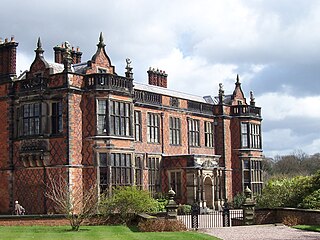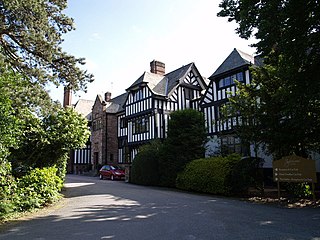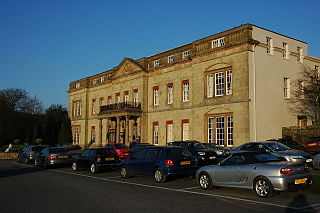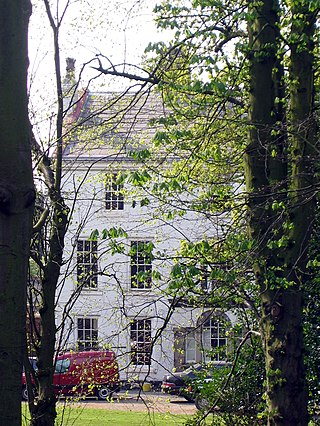Ingersley Hall, later Savio House, stands to the east of the town of Bollington, Cheshire, England. The house was built in about 1775 for John Gaskell. Extensions were added to it in 1833 for John Upton Gaskell. [1] The house was sold by the Gaskell family in 1933. In the 1950s it was taken over by a religious order, the Salesians of Don Bosco, and renamed Savio House. [2] As of 2011 the house is used as a retreat and activities centre for young people. [3] The front of the house is constructed in ashlar, with the remainder in coursed sandstone rubble. The house is roofed in Welsh slate and has stone chimneys. It has a rectangular plan and is in two storeys. The architectural style is Greek Revival. The north front is symmetrical with five bays divided by pilasters. The porch is in Doric style. The west front has eight bays, the central three of which were in the original house. All the windows in the north and west fronts are sashes with 12 panes. The south door is in Tuscan style, and was probably moved from the west front. The house is recorded in the National Heritage List for England as a designated Grade II listed building. [4] Also listed at Grade II is a former coach house to the south of the hall, built in about 1850, and converted into a conference hall in about 1950. [5]

Lyme Park is a large estate south of Disley, Cheshire, England, managed by the National Trust and consisting of a mansion house surrounded by formal gardens and a deer park in the Peak District National Park. The house is the largest in Cheshire, and is recorded in the National Heritage List for England as a designated Grade I listed building.

Tabley House is an English country house in Tabley Inferior, some 3 kilometres (1.9 mi) to the west of the town of Knutsford, Cheshire. The house is recorded in the National Heritage List for England as a designated Grade I listed building. It was built between 1761 and 1769 for Sir Peter Byrne Leicester, to replace the nearby Tabley Old Hall, and was designed by John Carr. The Tabley House Collection exists as an exhibition showcased by the University of Manchester.

Arley Hall is a country house in the village of Arley, Cheshire, England, about 4 miles (6 km) south of Lymm and 5 miles (8 km) north of Northwich. It is home to the owner, Viscount Ashbrook, and his family. The house is a Grade II* listed building, as is its adjacent chapel. Formal gardens to the southwest of the hall are also listed as Grade II* on the National Register of Historic Parks and Gardens. In the grounds are more listed buildings, a cruck barn being listed as Grade I, and the other buildings as Grade II.

In the early 18th century the Oulton Estate was home to the Egerton family and comprised a manor house and a formal garden surrounded by farmland in Cheshire, England. Later in the century the farmland was converted into a park. The estate is now the site of the motor racing track called Oulton Park.

Peel Hall is a country house near the village of Ashton Hayes, Cheshire, England. It is recorded in the National Heritage List for England as a designated Grade II* listed building. It was built as a mansion in 1637, but was much reduced in size by 1812, and was later used as a farmhouse. It is constructed in sandstone and has slate roofs. Its architectural style is Jacobean.

Birtles Hall is a country house in the parish of Over Alderley, Cheshire, England. It was built in about 1819 for the West Indies merchant Robert Hibbert.
Chorlton Hall is a country house to the east of the village of Backford, Cheshire, England.

Cranage Hall is a former country house in the village of Cranage, Cheshire, England. It was built in 1828–29 for Lawrence Armitstead, and designed by Lewis Wyatt. In 1932 a parallel wing was added. Since the hospital closed, it has been used as a hotel and conference centre owned and run by the Principal Hayley hotel group. The building is constructed in red brick with blue brick diapering, and in yellow sandstone. It is roofed in slate. The architectural style is Elizabethan. The building is in two storeys plus a basement, and it has eight bays. The first and fourth bays are in stone; the others are in brick. In front of the sixth and seven bays is a two-storey stone porch with four fluted Doric columns, an entablature with a frieze, and a balcony with an openwork balustrade. Between the third and fourth bays is a slim octagonal tower with an ogee cap and a weathervane. The house is recorded in the National Heritage List for England as a designated Grade II listed building.
Endon Hall is a country house to the south of Bollington and to the west of Kerridge Hill in Cheshire, England. It was built for William Clayton who developed a quarry nearby. Building of the house started in the 1830s, and it was enlarged in the 1850s. Associated with the house are two structures recorded in the National Heritage List for England as designated Grade II listed buildings. In the farm to the east of the house are stables, built at the same time as the house. They are constructed in coursed buff sandstone rubble with ashlar dressings, and have Kerridge stone-slate roofs. The stables are in two storeys, with a courtyard plan. They have a symmetrical front of five bays, with the central and end bays stepped slightly forward. In the centre bay is a coach entrance. The parapet is castellated. On the roof is a two-tier dovecote with a clock in the upper tier. Also on the roof is a hexagonal wooden open bellcote with a copper-domed roof and a weathervane. In the garden to the south of the house is a sandstone icehouse, built in about 1840.

Hankelow Hall is a former country house to the north of the village of Hankelow, Cheshire, England.

Inglewood is a house to the north-west of the village of Ledsham, Cheshire, England. It was built in 1909, but is dated 1915. The house was built for Frederick H. Fox, a Liverpool millionaire who made his fortune in marine insurance. It was later one of the seats of the Gordon family. As of 2011 it is a hotel called Inglewood Manor Hotel. The house is mainly half-timbered, with stone dressings, and brick chimneys decorated with diapering. It is roofed with Lakeland slate. Its architectural style is late Arts and Crafts. The house has a rectangular plan, with three fronts in two and three storeys. The entrance is on the east front, which has eight bays; the south and west fronts each have five bays. On the south side is a balcony overlooking the gardens. The house is recorded in the National Heritage List for England as a designated Grade II listed building. Also listed Grade II are the south and west terrace walls of the garden, and the east terrace walls and a pergola.

Lea Hall is a former country house standing to the northwest of the village of Wimboldsley, Cheshire, England. It dates from the early part of the 18th century, and was built for the Lowndes family. During the 19th century the house was owned by Joseph Verdin. Additions, including dormer windows, were made in the 19th century. During the 20th century the house was divided into three flats. The house is constructed in red brick with ashlar dressings and a tiled roof. It is in two storeys, with an attic and a basement. The roof is large and hipped, with a viewing platform. The entrance front is symmetrical, in five bays, the central bay protruding slightly forward. This bay contains a doorway with a swan's nest pediment decorated with scrolls, and containing a crest with the initials J V. The authors of the Buildings of England series describe the house as a "perfect brick box, delightful if just a little funny to look at". It is recorded in the National Heritage List for England as a designated Grade II* listed building.
Lymm Hall is a moated country house in the village suburb of Lymm in Warrington, Cheshire, England. It is recorded in the National Heritage List for England as a designated Grade II* listed building.
Oughtrington Hall was a country house located in Oughtrington Lane to the east of the village of Lymm in Cheshire, England.

Shrigley Hall is a former country house standing to the northwest of the village of Pott Shrigley, Cheshire, England. It has since been used as a school, when a chapel was added, and later as a hotel and country club operated by The Hotel Collection.

Stretton Hall is a country house in the parish of Stretton in Cheshire, England. It was built in about 1763 for John Leche. The house is constructed in brick on a sandstone basement, with painted stone dressings, and a slate roof. It has three symmetrical elevations. The entrance front is in three two-storey bays with a single-storey wing on each side. The central bay is canted, with five steps leading up to a doorway with a pediment. The windows are sashes. The garden front has similar windows, other than the wings, each of which contains a Venetian window. To the right of the house is attached a further wing, converted from the 17th-century stable of an earlier house. The house and former stable area is recorded in the National Heritage List for England as a designated Grade II* listed building. The sandstone garden walls are listed at Grade II.

Willaston Old Hall is a former manor house in the village of Willaston, in the unitary authority of Cheshire West and Chester, England. The building carries the date 1558, but both the authors of the Buildings of England series, and Figueirdo and Treuherz, argue that this date is too early for the architectural style of the house. Figueirdo and Treuherz are of the opinion that it was built in the early 17th century for Hugh Bennet. The house is constructed in red brick and stands on a red sandstone plinth. It has sandstone dressings and quoins, and a slate roof with stone ball finials. The entrance front is symmetrical, and consists of five bays, with three storeys. The central and the outer bays project forward and are gabled. The windows are mullioned and transomed. The house is recorded in the National Heritage List for England as a designated Grade II* listed building.

Hapsford Hall is a country house about 1 mile (1.6 km) south-west of Helsby, Cheshire, England. It was built in the late 18th or early 19th century and incorporates a former farmhouse; additions and alterations have been made since it was built. It is constructed in brick and stone, stands on a stone plinth, and has stone quoins and a hipped slate roof. The house is in three storeys, with cellars and an attic, and has a symmetrical front of three bays. Most of the windows on the front are sashes; elsewhere are casement windows. An embattled stone porch projects from the centre. The house is recorded in the National Heritage List for England as a designated Grade II listed building.

Moore Hall is a country house located in the village of Moore, Cheshire, England. It was built in the early 18th century, and is constructed in roughcast brick with a slate roof. The house has three storeys, and is in five bays. The porch is a more modern, and is fronted by a Venetian window. The windows are sashes. The house is recorded in the National Heritage List for England as a designated Grade II* listed building.

The Gaskell Memorial Tower and King's Coffee House are in King Street, Knutsford, Cheshire, England. As originally built, it had the triple function of being council offices, a coffee house, and a memorial to the novelist Elizabeth Gaskell, a former resident of the town who is often known as Mrs Gaskell. The building was designed by Richard Harding Watt with assistance from W. Longworth, and was opened in 1907. Its design incorporates features of many styles of architecture, and has not been praised by all critics. Incorporated on the tower are two depictions of Mrs Gaskell, a stone bust and a bronze relief. The building is recorded in the National Heritage List for England as a designated Grade II* listed building. The building is owned by Knutsford Town Council but since the early 1970s it has been used as a restaurant.
53°17′36″N2°05′00″W / 53.29324°N 2.08322°W